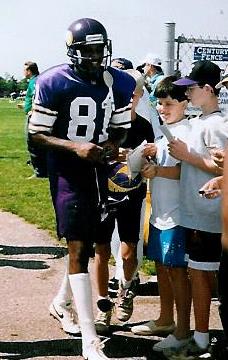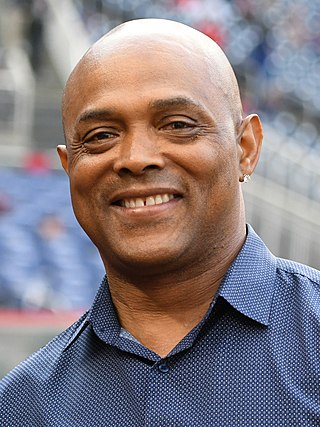
Desmond Kevin Howard is an American former football wide receiver and return specialist who played in the National Football League (NFL) for 11 seasons. He played college football for the Michigan Wolverines, where he was a two-time All-American, including a unanimous All-American selection in 1991, winning the Heisman Trophy. He was selected fourth overall in the 1992 NFL Draft by the Washington Redskins. Howard spent most of his career on special teams as a return specialist and holds the NFL single season record for punt return yardage. With the Green Bay Packers, Howard was named Most Valuable Player of Super Bowl XXXI after setting an NFL record for punt return yards and returning a kickoff for a 99-yard touchdown, the longest return in Super Bowl history at the time. To date, he is the only special teams player to receive the award. He was inducted to the College Football Hall of Fame in 2010.

Eugene Edward "Mercury" Morris is an American former professional football player who was a running back and kick returner. He played for eight years, primarily for the Miami Dolphins, in the American Football League (AFL) as a rookie in 1969 then in the American Football Conference (AFC) following the 1970 merger with the National Football League (NFL).

Anthony “AC” Carter is an American former professional football player who was a wide receiver for 13 years in the United States Football League (USFL) and National Football League (NFL). He made three-consecutive Pro Bowls for the Minnesota Vikings and was honored by Minnesota as one of the 50 Greatest Vikings of all time. Carter played college football for the Michigan Wolverines, finishing his career as a three-time All-American, and a two-time unanimous All-American selection. He is currently third all-time in receiving yards, and second all-time in receiving touchdowns for the University of Michigan.
Anthony Davis, also known as "A.D.", is an American former professional football player who was a running back. He played in four professional leagues: the World Football League (WFL), Canadian Football League (CFL), National Football League (NFL), and United States Football League (USFL).

Brian Keith Mitchell is an American former football running back and return specialist who played in the National Football League (NFL). He played college football as a quarterback for the Southwestern Louisiana Ragin' Cajuns and was selected by the Washington Redskins in the fifth round of the 1990 NFL draft. Mitchell is considered one of the greatest return specialists in NFL history.

Joshua Cribbs is an American former football wide receiver and return specialist who played in the National Football League (NFL). He played college football for the Kent State Golden Flashes and was signed by the Cleveland Browns as an undrafted free agent after the 2005 NFL draft. Cribbs is tied for the second most NFL career record with eight kickoff returns for touchdowns, and also the NFL record with two kickoffs of 100 yards or more returned for touchdowns in a single game. He has also played for the New York Jets, the Oakland Raiders and the Indianapolis Colts. He was most recently a special teams coaching intern for the Cleveland Browns.
The Minnesota Vikings is an American football franchise based in Minneapolis, Minnesota. The team was established in 1961 and is part of the National Football League's NFC North division. Since then, the team has taken part in the NFL playoffs 31 times, reaching four Super Bowls in 1970, 1974, 1975 and 1977.
Kevin Ray Williams, Jr. is an American former professional football player who was a wide receiver in the National Football League (NFL) for the Dallas Cowboys, Arizona Cardinals, Buffalo Bills and San Francisco 49ers. He played college football for the Miami Hurricanes, earning first-team All-American honors in 1991.
Richard Reese Byas, Jr. is a former American football defensive back in the National Football League (NFL); he was also a 1987 inductee to the Wayne State University Athletic Hall of Fame.

Gordon Granville Bell is an American former professional football player who was a running back, kickoff returner and punt returner who played for the Michigan Wolverines from 1973 to 1975, and professionally for the New York Giants (1976-1977) and St. Louis Cardinals (1978) of the National Football League (NFL).
George William Hoey is an American former professional football player who was a defensive back, punt returner and kickoff returner in the National Football League (NFL). He played college football for the Michigan Wolverines (1966–1968) and in the NFL for the Arizona Cardinals (1971), New England Patriots (1972–1973), San Diego Chargers (1974), Denver Broncos (1975), and New York Jets (1975).
Dorien Lamar Bryant is a former American football wide receiver. He went undrafted in the 2008 NFL Draft, but later signed with the Pittsburgh Steelers as a free agent.
David Elmer "Bo" Rather was an American football player. He played college football for the University of Michigan from 1970 to 1972 and professional football as a wide receiver in the National Football League (NFL) for the Miami Dolphins in 1973 and 1978 and for the Chicago Bears from 1974 to 1978. In six years of playing in the NFL, Rather appeared in 64 games and had 92 receptions for 1,467 yards and seven touchdowns.

The 1974 Michigan Wolverines football team was an American football team that represented the University of Michigan in the 1974 Big Ten Conference football season. In their sixth year under head coach Bo Schembechler, the Wolverines compiled a 10–1 record, outscored opponents 324 to 75, and were ranked #3 in final AP Poll. Michigan won the first ten games of the 1974 season in convincing fashion, including blowout victories over Colorado (31-0), Navy (52-0), Minnesota (49-0), and Purdue (51-0). In the final game of the season, #2 Michigan faced #3 Ohio State. The Wolverines lost by a score of 12-10, as place-kicker Mike Lantry missed a last-minute field goal that would have given Michigan a victory.

The 1972 Michigan Wolverines football team was an American football team that represented the University of Michigan in the 1972 Big Ten Conference football season. In their fourth season under head coach Bo Schembechler, the Wolverines compiled a 10–1 record, outscored opponents 264–57, and were ranked sixth in both final polls. Offensive guard Tom Coyle and defensive back Randy Logan were the team captains.

The 1971 Michigan Wolverines football team was an American football team that represented the University of Michigan in the 1971 Big Ten Conference football season. In their third season under head coach Bo Schembechler, the Wolverines compiled an 11–1 record, outscored opponents 421 to 83, won the Big Ten Conference championship, and were ranked No. 4 in the final UPI Poll and No. 6 in the final AP Poll. Defensive back Frank Gusich and center Guy Murdock were the team captains.

Darrell L. Harper was an American football player. He played at the halfback position for the University of Michigan from 1957 to 1959 and for the Buffalo Bills in the 1960 AFL season. On September 11, 1960, Harper scored the first official points in the history of the Bills. He also made the Bills' first kickoff, first field goal and first extra point kick.
Ed Shuttlesworth is a former American football fullback.

Carl Davis Ward is a former American football player. He played college football as a halfback for the University of Michigan from 1964 to 1966 and professional football in the National Football League (NFL) for the Cleveland Browns and New Orleans Saints from 1967 to 1969.

Steven William Breaston is a former American football wide receiver. He played college football at the University of Michigan and was selected by the Arizona Cardinals in the fifth round of the 2007 NFL Draft. He also played for the Kansas City Chiefs.










